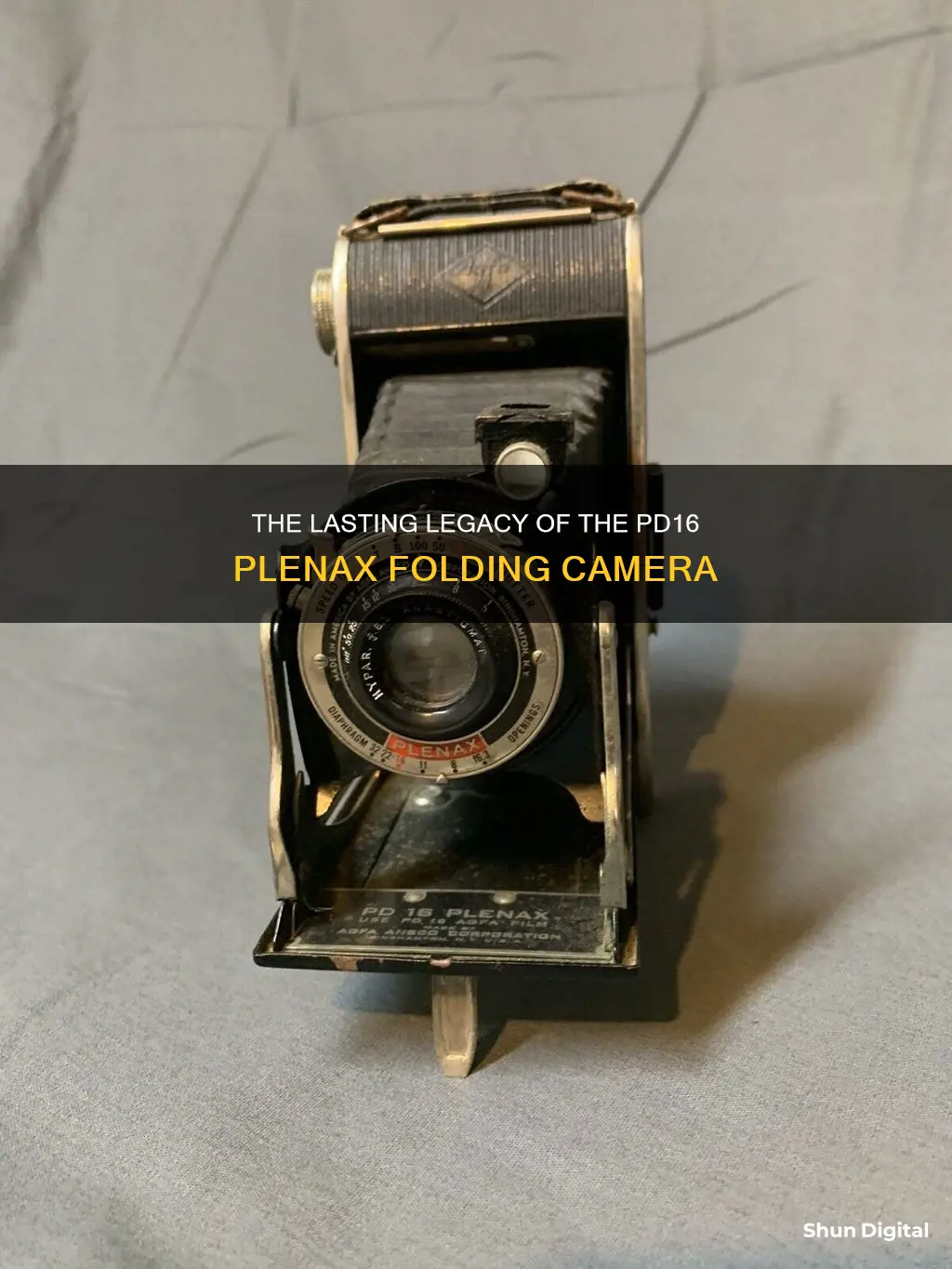
The Agfa-Ansco PD16 Plenax camera was manufactured by the Agfa company from 1935 to approximately 1941. It was a low-cost folding bed roll film camera. The camera featured a reversible brilliant finder, tripod sockets, viewing windows, streamlined design, and handy controls.
| Characteristics | Values |
|---|---|
| Years of Manufacture | 1935 to approximately 1941 |
| Manufacturer | Agfa Company |
| Type | Low-cost folding bed roll film camera |
| Lens Options | Antar f/14, Tripar F/11, or Hypar F/6.3 |
| Shutter Speed | 1/50s |
| Film Type | PD16 roll film (equivalent to Kodak's designation 616) |
| Print Capacity | 8 exposures of 2½ x 4¼ inch or 16 exposures of 2½ x 2⅛ inch |
| Features | Swivelling/reversible brilliant finder, tripod sockets, two covered red viewing windows, chrome detailing, Agfa rhombus logo |
| Dimensions | Approximately 7 1/2 inches width, 6 inches depth, and 3 1/2 inches height |
What You'll Learn
- The Agfa-Ansco PD16 Plenax was manufactured from 1935 to 1941
- It was a low-cost folding camera with a roll film design
- The camera featured a reversible brilliant finder and tripod sockets
- There were three lens options: Antar f/14, Tripar F/11, and Hypar F/6.3
- The Agfa PD16 Clipper was a different design but used the same film size

The Agfa-Ansco PD16 Plenax was manufactured from 1935 to 1941
The PD16 Plenax offered three lens options: the Antar f/14, the Tripar F/11, and the Hypar F/6.3. The Antar f/14 was fitted with a simple leaf shutter, providing time and instantaneous functions. The camera also included a socket for a cable release. The aperture range for the PD16 Plenax was f/14 to f/32, and it featured a yellow filter that could be used to enhance cloud effects and improve colour rendition in landscapes and flower photography.
The PD16 Plenax was part of a series of folding cameras for type PD16 roll film, which was equivalent to Kodak's 616 film. Many models in this series were distinguished by their lens designations: Antar (f/14), Hypar (f6.3), or Tripar (f/11). Some models were designated "Plenax", regardless of the lens type, and included higher-specification models with Hypar f/6.3 Anastigmat lenses and shutters offering T, B, 100, 50, and 25 settings.
The Agfa-Ansco PD16 Plenax, with its Art Deco design elements, was produced during the main Art Deco period, featuring geometric chrome strips, glossy black enamel on side panels, and chrome and leatherette details.
Understanding Your Camera's Battery Symbol
You may want to see also

It was a low-cost folding camera with a roll film design
The Agfa-Ansco PD16 Plenax is a low-cost folding camera with a roll film design. It was manufactured by the Agfa company from 1935 to approximately 1941. The PD16 is part of the Agfa PD or Agfa Ansco PD 16 series of folding cameras for type PD16 roll film (equivalent to Kodak's designation 616). The PD16 Plenax is capable of capturing eight exposures of 2½ x 4¼ inch or 16 exposures of 2½ x 2⅛ on no. 616 film.
The camera features a swivelling or reversible brilliant finder, tripod sockets, and two covered red windows or viewing windows. It also has a chrome film winder, chrome viewfinder detailing, and a chrome table stand. The PD16 Plenax offers three lens options: the Antar f/14, the Tripar F/11, and the Hypar F/6.3. The Antar f/14 is equipped with a simple leaf shutter, providing time and instantaneous functions, while the Hypar lens offers a more advanced shutter with adjustable speeds up to 1/100 of a second.
The Agfa-Ansco PD16 Plenax showcases an iconic Art Deco design. Its aesthetic features include geometric chrome strips, glossy black enamel on the side panels, and a faceplate adorned with glossy black enamel and chrome. The camera's body leatherette bears the Agfa rhombus logo, and the Agfa Ansco logo is impressed on the strap.
The PD16 Plenax's low-cost design and versatile features made it a popular choice for photographers during its production period, from the mid-1930s to the early 1940s.
Low Power Mode: Impact on Camera Quality
You may want to see also

The camera featured a reversible brilliant finder and tripod sockets
The Agfa-Ansco PD16 Plenax camera was manufactured by the Agfa company from 1935 to approximately 1941. It was designed as a low-cost folding bed roll film camera. The camera features a reversible brilliant finder, tripod sockets, and two covered red windows. The finder and tripod sockets are particularly notable features.
The reversible brilliant finder is a type of viewfinder that uses a prism or mirror system to provide a bright and clear image for composition and focusing. It is called "brilliant" because of the brightness and clarity of the image it provides. This finder can be reversed or swivelled, allowing for more convenient viewing when taking photographs. This was a common feature on folding cameras of the time, as it allowed the camera to maintain a compact form factor while still offering a comfortable viewing experience for the photographer.
The tripod sockets provide stability and support for the camera when mounted on a tripod. This is particularly important for the PD16 Plenax, as its shutter speed is limited to only 1/50s. By using a tripod or mounting the camera on a solid object, photographers can minimise the risk of blurry or unsteady images. The tripod sockets enable photographers to capture clear and sharp photographs, even in low-light conditions or when using slower shutter speeds.
The camera offered three lens options: an Antar f/14, a Tripar F/11, or a Hypar F/6.3. The Antar f/14 lens features a simple leaf shutter, providing time and instantaneous functions. The Tripar F/11 and Hypar F/6.3 lenses offered higher specifications, with the Hypar f/6.3 lens including an anastigmat design. The availability of different lenses allowed photographers to choose the option that best suited their needs and preferences, whether it was for landscape, portrait, or general photography.
Overall, the reversible brilliant finder and tripod sockets of the PD16 Plenax camera contributed to its functionality and ease of use, making it a versatile and accessible option for photographers during its time.
Charging Camera Batteries: A Quick Guide to Powering Up
You may want to see also

There were three lens options: Antar f/14, Tripar F/11, and Hypar F/6.3
The Agfa-Ansco PD16 Plenax camera was manufactured by the Agfa company from 1935 to approximately 1941. It was designed as a low-cost folding bed roll film camera. The PD16 Plenax camera offered three lens options: the Antar f/14, the Tripar F/11, and the Hypar F/6.3.
The Antar f/14 lens is fitted with a simple leaf shutter, providing time and instantaneous functions. It also has a socket for cable release. The aperture range for this lens is f/14 to f/32. Additionally, the Antar f/14 lens features a yellow filter that can be swung into place when shooting at the f/14 setting. This yellow filter can enhance cloud effects and improve colour rendition when photographing landscapes and flowers.
The Tripar F/11 lens is a focusing lens, as seen in images of the Agfa-Ansco PD16 Plenax camera.
The Hypar F/6.3 is an anastigmat lens, and it is featured in the higher-specification models of the PD16 Plenax camera. This lens offers shutter settings of T, B, 100, 50, and 25.
Best Buy's Camera Battery Charger Options Explored
You may want to see also

The Agfa PD16 Clipper was a different design but used the same film size
The Agfa PD16 Plenax camera was manufactured by the Agfa company from 1935 to approximately 1941. It was a low-cost, folding roll film camera that used either no. 616 film or 120 film with an adapter. The PD16 Plenax featured a swivelling brilliant finder, tripod sockets, and two covered red windows. The camera was capable of capturing eight 2½ x 4¼ inch exposures or sixteen 2½ x 2⅛ inch exposures on a roll of film.
The PD16 Clipper was introduced in about 1926 and was produced until the 1950s. It was a 616-format viewfinder camera made by Agfa Ansco in Binghampton, USA. The unit shown in the image below is the second model, which already has the integrated viewfinder, but still lacks the accessory shoe. It dates to the 1930s.
[Image of the Agfa PD16 Clipper](https://www.flickr.com/photos/tags/agfa%20pd16%20clipper/)
Importing Camera Raw Files into Adobe Premiere: A Step-by-Step Guide
You may want to see also
Frequently asked questions
The PD16 Plenax folding camera was first manufactured in 1935.
The last PD16 Plenax folding camera was made in 1941.
The PD16 Plenax folding camera was made by the Agfa company.
The PD16 Plenax is a low-cost folding bed roll film camera. It is capable of capturing eight exposures of 2½ x 4¼ inch or 16 exposures of 2½ x 2⅛ on no. 616 film. It features a swivelling brilliant finder, tripod sockets, and two covered red windows.







